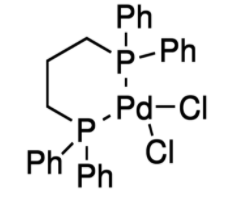DICHLORO[1,3-BIS(DIPHENYLPHOSPHINO)PROPANE]PALLADIUM(II) CAS#: 59831-02-6; ChemWhat Code: 33302
Identification
| Product Name | DICHLORO[1,3-BIS(DIPHENYLPHOSPHINO)PROPANE]PALLADIUM(II) |
| IUPAC Name | dichloropalladium;3-diphenylphosphanylpropyl(diphenyl)phosphane |
| Molecular Structure |  |
| CAS Registry Number | 59831-02-6 |
| EINECS Number | No data available |
| MDL Number | MFCD03844773 |
| Beilstein Registry Number | No data available |
| Synonyms | bis(diphenylphosphino)propanepalladium(II) dichloride, (1,3-bis(diphenylphosphino)propane)palladium(II) dichloride, [1,3-bis(diphenylphosphino)propane]palladium(II)dichloride, (1,3-bis(diphenylphosphino)propane)palladium(II) chloride, [1,3-bis(diphenylphosphino)propane]palladium(II) chloride, dichloro(1,3-bis(diphenylphosphanyl)propane)palladium(II), dichloro(1,3-bis(diphenylphosphino)propane)palaldium(II) |
| Molecular Formula | C27H26Cl2P2Pd |
| Molecular Weight | 589.769 |
| InChI | InChI=1S/C27H26P2.2ClH.Pd/c1-5-14-24(15-6-1)28(25-16-7-2-8-17-25)22-13-23-29(26-18-9-3-10-19-26)27-20-11-4-12-21-27;;;/h1-12,14-21H,13,22-23H2;2*1H;/q;;;+2/p-2 |
| InChI Key | LDFBXJODFADZBN-UHFFFAOYSA-L |
| Canonical SMILES | c1ccc(cc1)P(CCCP(c2ccccc2)c3ccccc3)c4ccccc4.Cl[Pd]Cl |
| Patent Information | ||
| Patent ID | Title | Publication Date |
| US2004/2612 | Process for producing fluorine-containing, polymerizable styrene monomer and intermediates used in same | 2004 |
Physical Data
| Appearance | Off-white crystalline powder |
| Solubility | Soluble in dichloromethane. |
| Sensitivity | Air Sensitive |
| Melting Point, °C |
| 277 |
| Density, g·cm-3 | Measurement Temperature, °C | Type (Density) |
| 1.609 | -73.16 | crystallographic |
Spectra
| Description (NMR Spectroscopy) | Nucleus (NMR Spectroscopy) | Solvents (NMR Spectroscopy) | Temperature (NMR Spectroscopy), °C | Frequency (NMR Spectroscopy), MHz |
| Chemical shifts | 1H | chloroform-d1 | 20 | 300 |
| Chemical shifts | 31P | chloroform-d1 | 20 | 121 |
| Chemical shifts, Spectrum | 1H | dimethylsulfoxide-d6 | 400 | |
| 31P | not given | |||
| 31P | dimethyl sulfoxide | |||
| 31P | tetrahydrofuran | 25 | ||
| 31P | CDCl3 | |||
| Spectrum, Linewidth of NMR absorption | 31P | solid |
| Description (IR Spectroscopy) | Solvent (IR Spectroscopy) | Comment (IR Spectroscopy) |
| Bands, Spectrum | potassium bromide | |
| Bands | nujol | 290 cm**-1 – 306 cm**-1 |
| Description (UV/VIS Spectroscopy) | Solvent (UV/VIS Spectroscopy) | Absorption Maxima (UV/VIS), nm | Ext./Abs. Coefficient, l·mol-1cm-1 |
| Band assignment, Spectrum | dimethyl sulfoxide | 231, 313 | 62795, 79096 |
| Spectrum | dimethyl sulfoxide | 269, 327 | 46900, 11400 |
| Spectrum | acetonitrile | 326 |
Route of Synthesis (ROS)
![Route of Synthesis (ROS) of DICHLORO[1,3-BIS(DIPHENYLPHOSPHINO)PROPANE]PALLADIUM(II) CAS 59831-02-6](https://www.chemwhat.com/wp-content/uploads/2017/11/Route-of-Synthesis-ROS-of-DICHLORO13-BISDIPHENYLPHOSPHINOPROPANEPALLADIUMII-CAS-59831-02-6.png)
| Conditions | Yield |
| With hydrogenchloride In ethanol; dichloromethane for 3h; Reflux; Experimental Procedure Synthesis of [Pd(k2-dppp)Cl2] (3) The solution of dppp (1.2373g, 3mmol)in 15ml CH2Cl2 was added to a solution of PdCl2(0.5320g, 3mmol) that dissolved in 2 cm3 ethanoland 2cm3 concentrate HCl. The mixture was reuxfor 3 hrs. And then the solvent was evaporate at roomtemperature to give pale yellow precipitate. A smallportion of this complex was dissolve in CH2Cl2 and setto slow evaporation at room temperature after a oneweek, the yellow colored needle crystals were formedsuitable for single-crystal diffraction analysis15. TheMelting point is 277°C, yield is 1.664gm (94%),formula: [Pd(k2-dppp)Cl2] and M.wt.is 589.72gm/mole.as shown in Figure 1. | 94% |
| In dimethyl sulfoxide prepn. according to: A. Westland, J. Chem. Soc., (1965) 3060; ligand is mixed with PdCl2 in DMSO and heated at 100°C until a clear soln. is obtained; cooling down, filtration, washing with pentane; | >90 |
| In not given | |
| In N,N-dimethyl-formamide at 20℃; |
Safety and Hazards
| Pictogram(s) |  |
| Signal | Warning |
| GHS Hazard Statements | H302 (86.67%): Harmful if swallowed [Warning Acute toxicity, oral] H312 (86.67%): Harmful in contact with skin [Warning Acute toxicity, dermal] H315 (100%): Causes skin irritation [Warning Skin corrosion/irritation] H319 (100%): Causes serious eye irritation [Warning Serious eye damage/eye irritation] H332 (86.67%): Harmful if inhaled [Warning Acute toxicity, inhalation] H335 (95.56%): May cause respiratory irritation [Warning Specific target organ toxicity, single exposure; Respiratory tract irritation]environment, long-term hazard] Information may vary between notifications depending on impurities, additives, and other factors. |
| Precautionary Statement Codes | P261, P264, P270, P271, P280, P301+P312, P302+P352, P304+P312, P304+P340, P305+P351+P338, P312, P321, P322, P330, P332+P313, P337+P313, P362, P363, P403+P233, P405, and P501 (The corresponding statement to each P-code can be found at the GHS Classification page.) |
Other Data
| Transportation | NONH for all modes of transport |
| Under the room temperature and away from light | |
| HS Code | 294200 |
| Storage | Under the room temperature and away from light |
| Shelf Life | 1 year |
| Market Price | USD |
| Druglikeness | |
| Lipinski rules component | |
| Molecular Weight | 589.777 |
| HBA | 0 |
| HBD | 0 |
| Matching Lipinski Rules | 2 |
| Veber rules component | |
| Polar Surface Area (PSA) | 0 |
| Rotatable Bond (RotB) | 4 |
| Matching Veber Rules | 2 |
| Use Pattern |
| Often used as a catalyst. |
Buy Reagent | |
| No reagent supplier? | Send quick inquiry to ChemWhat |
| Want to be listed here as a reagent supplier? (Paid service) | Click here to contact ChemWhat |
Approved Manufacturers | |
| Warshel Chemical Ltd | http://www.warshel.com/ |
| Want to be listed as an approved manufacturer (Requires approvement)? | Please download and fill out this form and send back to approved-manufacturers@chemwhat.com |
Contact Us for Other Help | |
| Contact us for other information or services | Click here to contact ChemWhat |
